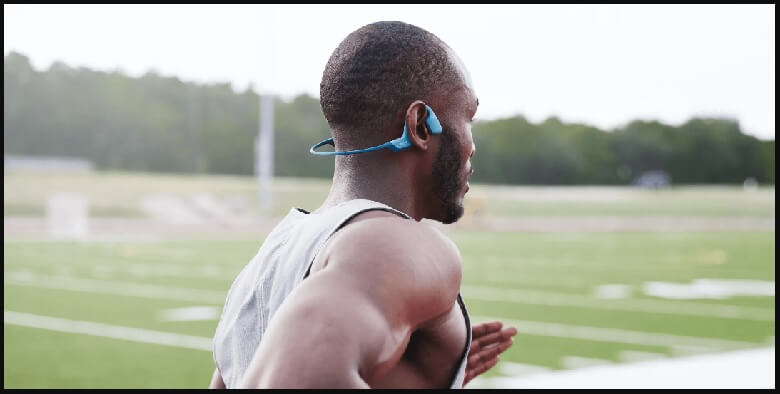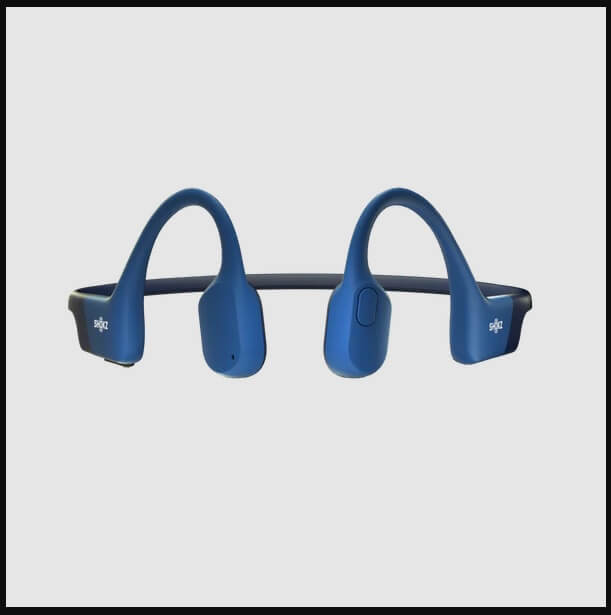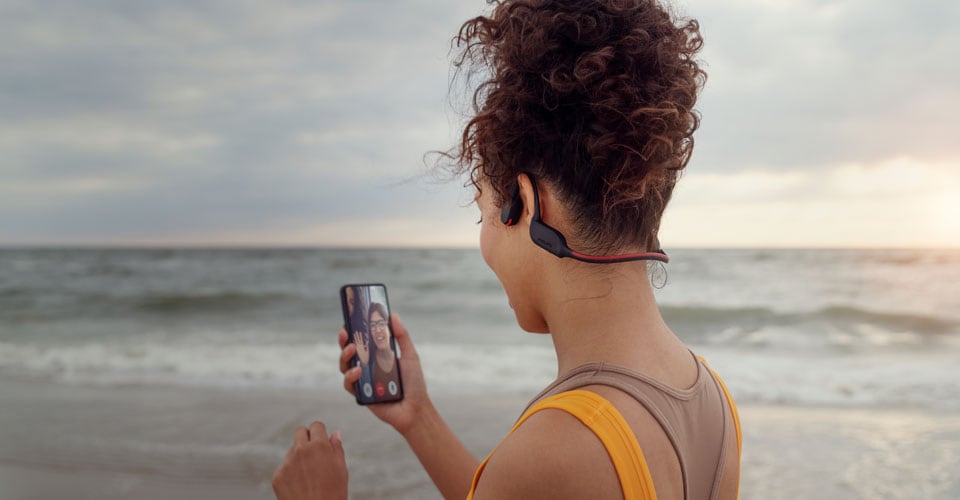Bone conduction headphones with Bluetooth technology are a type of headphones that transmit sound through vibrations in the bones of the face, bypassing the eardrums.
This allows for hands-free listening and eliminates the need for earbuds or ear cups that cover the ear.
The addition of Bluetooth connectivity provides wireless freedom and convenience, making them a popular choice among consumers.

*** TABLE OF CONTENTS ***
What are Bone Conduction Headphones with Bluetooth?
Bone conduction headphones are a unique type of headphones that allow you to listen to music and sounds without blocking your ears.
They work by transmitting vibrations through the bones in your face, bypassing your eardrums. This technology is becoming increasingly popular due to its convenience, comfort, and safety benefits.
With the advent of Bluetooth technology, bone conduction headphones are now able to connect wirelessly to your devices, allowing for greater mobility and flexibility.
There are many brands and models of Bluetooth bone conduction headphones available in the market, and in this guide, we will be mentioning some of the top brands and models, including Shokz, Vidonn, YouthWhisper, H2O Audio, Tayogo, 9 Digital, Moing, and Naenka.
Do bone conduction headphones use Bluetooth?
Yes, many bone conduction headphones use Bluetooth technology for wireless connectivity to your devices.
Bluetooth technology allows the headphones to transmit audio signals wirelessly from your devices to the headphones, eliminating the need for cords and wires.
This makes it convenient and easy to use your bone conduction headphones while on the go.
The Bluetooth technology in the headphones connects to your device through a process called pairing.
Once paired, the headphones and device can communicate wirelessly, allowing you to listen to music, make phone calls, or access other audio content.
The Bluetooth technology in bone conduction headphones ensures that the audio signal is transmitted clearly and without interruption, providing you with high-quality sound.
Advantages of Bluetooth Bone Conduction Headphones
Convenient wireless connection:
With Bluetooth technology, you don’t have to worry about cords or wires getting in the way while you use your headphones.
You can easily connect your headphones to your devices and move around freely while enjoying your music or taking phone calls.
Hands-free phone calls and music streaming:
Bluetooth bone conduction headphones allow you to make phone calls and stream music wirelessly from your device, making it easy to stay connected on the go.
Improved sound quality and comfort:
With advanced Bluetooth technology, bone conduction headphones deliver high-quality sound, providing you with an enjoyable listening experience.
Additionally, bone conduction headphones are designed for comfort, making it easy to wear them for extended periods of time.
Safe for outdoor activities and sports:
Because bone conduction headphones don’t obstruct your ear canals, you can hear your surroundings while using them, making them safe for outdoor activities and sports.
Disadvantages of Bluetooth Bone Conduction Headphones
Limited battery life compared to traditional headphones:
Bluetooth bone conduction headphones rely on battery power to function, and their battery life is often shorter than traditional headphones. This means you’ll have to recharge them more frequently or carry a backup power source.
Can be expensive:
Bluetooth bone conduction headphones can be more expensive than traditional headphones, which may not fit into everyone’s budget.
Potentially lower sound quality than traditional headphones:
While bone conduction headphones provide high-quality sound, they may not deliver the same level of sound quality as traditional headphones, especially for bass-heavy music genres.

What to look for when buying Bone Conduction Headphones with Bluetooth?
When shopping for Bluetooth bone conduction headphones, there are several factors to consider to ensure that you find the best pair for your needs:
Comfortable fit for extended use:
Look for headphones that offer a secure and comfortable fit, with adjustable sizing and lightweight construction for extended use.
Durable construction for outdoor activities and sports:
If you plan to use your headphones for outdoor activities or sports, look for a durable design that is water-resistant or waterproof.
Clear sound quality and call quality:
Choose headphones with clear sound quality and good call quality to ensure that you can hear your music and phone calls clearly.
Water-resistant or waterproof design:
If you plan to use your headphones in wet or humid environments, look for a water-resistant or waterproof design to protect your investment.
Compatibility with devices and voice assistants:
Ensure that your headphones are compatible with your devices and voice assistants, such as Siri or Google Assistant, for a seamless user experience.
Best Bluetooth Bone Conduction Headphones
There are many brands and models of Bluetooth bone conduction headphones available, making it difficult to choose the best one.
However, here is an overview of some of the top brands and models in the market:
Shokz:
Shokz is a leading brand in the bone conduction headphones market, offering a range of products including the OpenRun, OpenRun Pro, OpenRun Mini, OpenComm, OpenMove, Aeropex, Aeropex Mini, Air, and Titanium.
These headphones are known for their durability and long battery life.
Vidonn:
Vidonn offers a range of bone conduction headphones, including the F1, F3, and F3 Pro.
These headphones are known for their comfortable and secure fit, and high-quality sound.
YouthWhisper:
YouthWhisper offers a range of bone conduction headphones, including the Pro, Lite, and SuperQ3.
These headphones are known for their lightweight and comfortable design, and high-quality sound.
List of Bluetooth Bone Conduction Headphones
Here’s a list and comparison table for Bone Conduction Headphones with Bluetooth
Bone Conduction Headphones with Bluetooth
When choosing a Bluetooth bone conduction headphone, it’s important to consider factors such as battery life, sound quality, comfort, and design.
Additionally, different types of users and activities may require different features.
For example, a runner may prefer a headphone with a secure fit and long battery life, while someone looking for a more casual listening experience may prefer a headphone with a comfortable and lightweight design.
Ultimately, the best Bluetooth bone-conduction headphone for you will depend on your individual needs and preferences.
It’s important to research different brands and models, and read customer reviews, to help you make an informed decision.

What are the differences between Bone Conduction Headphones with Bluetooth and Bone Conduction Headphones with MP3 Player?
Bone conduction headphones have become increasingly popular over the years, with many people embracing the unique way in which they deliver sound.
One question that often arises when shopping for bone conduction headphones is whether to opt for a model with Bluetooth or an MP3 player.
In this article, we’ll explore the differences between bone conduction headphones with Bluetooth and those with an MP3 player to help you make an informed decision about which type of headphones is right for you.
Here are some key differences to consider:
- Connectivity: Bone conduction headphones with Bluetooth can connect to a wide range of devices wirelessly, whereas those with an MP3 player can only play music stored on the device itself.
- Convenience: With Bluetooth bone conduction headphones, you don’t have to carry a separate MP3 player or worry about connecting it to your headphones. Everything is streamlined and wireless.
- Battery Life: Bluetooth bone conduction headphones rely on a battery to power the wireless connection, which can reduce battery life compared to bone conduction headphones with an MP3 player.
- Audio Quality: Bone conduction headphones with an MP3 player generally offer better audio quality because they don’t rely on wireless transmission, which can sometimes result in loss of quality.
Ultimately, the decision between bone conduction headphones with Bluetooth vs. those with an MP3 player comes down to personal preference and how you plan to use the headphones.
If you want the convenience of wireless connectivity and plan to use your headphones with a variety of devices, Bluetooth headphones may be the way to go.
On the other hand, if you prioritize audio quality and don’t mind carrying a separate device, bone conduction headphones with an MP3 player may be the better choice.
Comparison of Bone Conduction Headphones with Bluetooth vs. Bone Conduction Headphones with MP3 Player
Here’s a comparison table for Bone Conduction Headphones with Bluetooth vs. Bone Conduction Headphones with MP3 Player:
Bone Conduction Headphones with Bluetooth vs. Bone Conduction Headphones with MP3 Player
Note: the actual features and performance may vary depending on the specific model of headphones being compared.
What are the Differences between Bone Conduction Headphones with Bluetooth and Traditional Headphones with Bluetooth?
When it comes to choosing the right headphones, there are many options available on the market.
Two popular types are bone conduction headphones with Bluetooth and traditional headphones with Bluetooth.
While both use Bluetooth technology, there are significant differences between the two.
Design and Comfort
Traditional headphones usually go over the ear or inside the ear, while bone conduction headphones sit outside the ear and use bone conduction technology to transmit sound.
This design allows the user to hear ambient sounds and have better situational awareness, making it an excellent choice for outdoor activities.
Bone conduction headphones are also more comfortable to wear for long periods, as they do not press against the ear canal.
Sound Quality
The sound quality of traditional headphones is often better than that of bone conduction headphones, as the sound is transmitted directly to the eardrum.
However, bone conduction headphones have made significant strides in sound quality in recent years and now offer a decent listening experience.
They are also ideal for people who cannot wear traditional headphones, such as those with hearing aids or earring wearers.
Connectivity
Both types of headphones use Bluetooth technology to connect to devices, but traditional headphones may have a better connection range and stability.
Bluetooth bone conduction headphones have a shorter range and may experience connection issues in crowded areas or around obstacles.
Battery Life
Bone conduction headphones with Bluetooth often have shorter battery life than traditional Bluetooth headphones.
However, this depends on the model and brand.
Some bone conduction headphones can last up to eight hours on a single charge, while some traditional headphones can only last a few hours.
Price
Bone conduction headphones with Bluetooth are often more expensive than traditional headphones with Bluetooth.
The technology used to produce them is more specialized, which adds to the cost.
In conclusion, both bone conduction headphones with Bluetooth and traditional headphones with Bluetooth have their strengths and weaknesses.
When choosing between the two, consider the intended use, sound quality, design, connectivity, battery life, and price.
Comparison between Bone Conduction Headphones with Bluetooth vs. Regular Headphones with Bluetooth
Comparison of traditional headphones and bone conduction headphones
What is the average cost of Bone Conduction Headphones with Bluetooth?
The average cost of Bone Conduction Headphones with Bluetooth varies widely depending on the brand, features, and quality.
The price can range from $25 to $200 or more. For instance, the Bone Conduction Headphones Bluetooth 5.0 by GreatSounds is priced at $89.99 on Amazon [1], while the Creative Outlier Free Pro is priced at $119.99 on the Creative website [2].
Meanwhile, the WiFair Bone Conduction Headphones with Bluetooth and microphone are priced at $25.99 on Amazon [3].
It is important to note that these prices are subject to change and may vary depending on factors such as availability and promotions.
What are the Common Customer Concerns Around the Use of Bone Conduction Headphones with Bluetooth?
How do you pair to Bluetooth Bone Conduction Headphones?
Pairing your Bluetooth bone conduction headphones to your device is a simple process, but the steps can vary depending on the brand and model of your headphones and your device’s operating system.
Here is a general guide to pairing your headphones to your device:
Turn on your headphones and place them in pairing mode. This is usually indicated by a flashing LED light or a specific pairing mode button.
On your device, go to the Bluetooth settings and select “search for new devices” or “add new device”.
Select your headphones from the list of available devices.
Follow the on-screen instructions to complete the pairing process. This may involve entering a passcode or confirming the connection.
Note: For specific pairing instructions, refer to the user manual or manufacturer’s website for your headphones and device.
Can you answer your phone with Bone Conduction Headphones?
Yes, many bone conduction headphones offer the ability to answer phone calls. The headphones typically have a built-in microphone that allows you to take calls hands-free.
When a call comes in, you can answer it directly from the headphones, eliminating the need to take out your phone and use it to answer the call.
The call quality when using bone conduction headphones can vary between different models, but many of the high-end headphones offer clear and crisp audio quality.
Some of the latest models even feature advanced call quality features like noise-cancellation, which helps to eliminate background noise, and voice control, which allows you to answer calls and control other features without touching the headphones.
Overall, being able to answer phone calls with your bone conduction headphones is a convenient feature that can enhance your overall experience and make it easier to stay connected on the go.
How long do Bluetooth Bone Conduction Headphones last?
The battery life of Bluetooth bone conduction headphones can vary between brands and models, but most offer several hours of use per charge.
For example, the Shokz OpenRun provides up to 8 hours of continuous playtime, while the Vidonn F3 offers up to 6 hours of battery life.
It’s important to note that the battery life can be affected by factors such as volume level and usage patterns, so it’s a good idea to check the manufacturer’s specifications before purchasing a pair of headphones.
Recharging times for Bluetooth bone conduction headphones can also vary.
For example, the Shokz OpenRun takes 2 hours to fully recharge, while the Vidonn F3 takes only 1 hour.
Are Bone Conduction Headphones Safe for work?
Yes, bone conduction headphones are safe for use at work.
You can use them safely at work, without disturbing others around you.
Can bone-conduction headphones damage your hearing?
While they offer several safety and design advantages when compared to regular headphones, bone-conduction headphones can still damage hearing when music or sound is played at high volumes.
Conclusion
Bone conduction headphones with Bluetooth technology offer a convenient and innovative way to listen to music, make phone calls, or access other audio content.
They transmit audio signals wirelessly from your devices to the headphones, eliminating the need for cords and wires.
The Bluetooth technology in bone conduction headphones ensures that the audio signal is transmitted clearly and without interruption, providing you with high-quality sound.
When considering purchasing a pair of Bluetooth bone conduction headphones, it’s important to consider the advantages and disadvantages, such as battery life, sound quality, and comfort.
It’s also important to consider what features are important to you, such as water resistance, noise-cancellation, or the ability to answer phone calls.
Final thoughts and recommendations: when choosing Bluetooth bone conduction headphones, consider your needs and preferences and look for headphones that offer the features that are important to you.
It’s also important to consider the brand reputation and customer reviews to ensure you’re making an informed decision.
You can check out our comprehensive guide to Bone Conduction Headphone Features here.